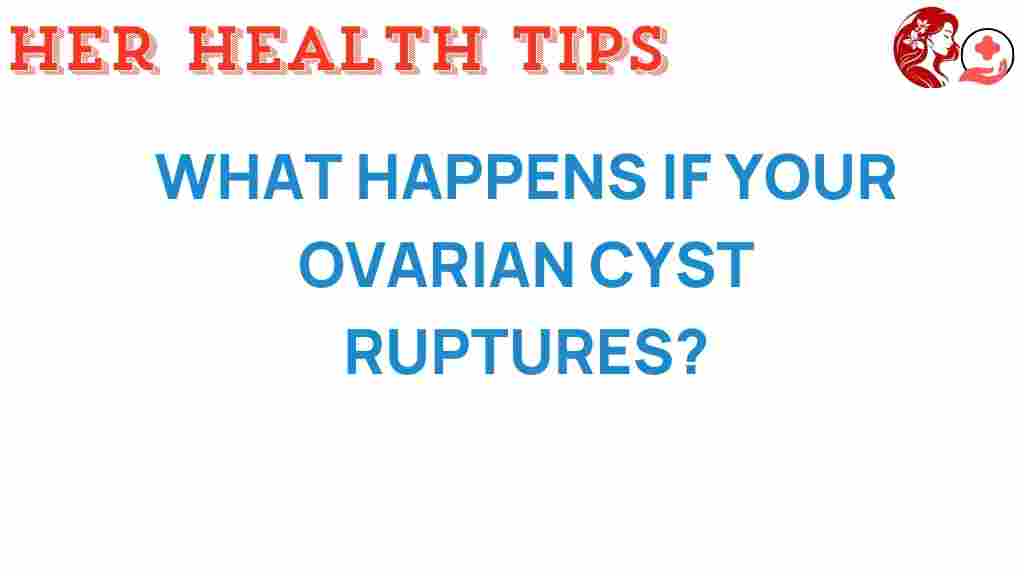The Hidden Risks: What Happens If Your Ovarian Cyst Ruptures?
Ovarian cysts are fluid-filled sacs that develop on the ovaries and are quite common among women of reproductive age. While many ovarian cysts are harmless and often resolve on their own, the potential for complications exists, particularly if a cyst ruptures. Understanding the implications of a ruptured cyst is crucial for maintaining women’s health and recognizing the symptoms that may arise. In this article, we will delve into the risks associated with ruptured cysts, their symptoms, diagnosis, and treatment options, as well as tips for safeguarding your reproductive health.
Understanding Ovarian Cysts
Ovarian cysts can develop for various reasons, and they are usually categorized into two main types:
- Functional Cysts: These are the most common type and usually form during the menstrual cycle. They typically go away on their own.
- Pathological Cysts: These are less common and may be filled with fluid or solid material. They require monitoring or treatment.
What is a Ruptured Cyst?
A ruptured cyst occurs when an ovarian cyst breaks open, releasing its contents into the pelvic cavity. This can lead to sudden and severe abdominal pain and may cause other serious health complications. Knowing the signs and symptoms of a ruptured cyst can help you seek appropriate medical attention promptly.
Symptoms of a Ruptured Cyst
Recognizing the symptoms is vital for early diagnosis and treatment. Common symptoms of a ruptured ovarian cyst include:
- Severe Abdominal Pain: A sudden onset of sharp or throbbing pain on one side of the lower abdomen.
- Pelvic Pain: Discomfort that may radiate to the lower back or thighs.
- Nausea and Vomiting: These symptoms may accompany the pain.
- Changes in Menstrual Cycle: Irregularities or heavier menstrual bleeding may occur.
- Faintness or Dizziness: Possible signs of internal bleeding, which can be serious.
If you experience any of these symptoms, especially severe abdominal pain, seek medical attention immediately to assess the situation and rule out other complications.
Health Risks Associated with a Ruptured Cyst
While many ruptured cysts are manageable, they can pose serious health risks, including:
- Internal Bleeding: A ruptured cyst can lead to bleeding into the abdomen, which can be life-threatening.
- Infection: There is a risk of infection if the contents of the cyst release into the pelvic cavity.
- Adhesions: Scar tissue may form as the body heals, leading to further complications such as chronic pelvic pain.
Diagnosis of a Ruptured Cyst
Healthcare providers typically use a combination of medical history, physical examination, and imaging tests to diagnose a ruptured ovarian cyst. Common diagnostic methods include:
- Pelvic Exam: A healthcare provider will check for tenderness or swelling in the pelvic region.
- Ultrasound: This imaging test helps visualize the cyst and assess if it has ruptured.
- Blood Tests: These tests can check for signs of infection or internal bleeding.
Treatment Options for a Ruptured Cyst
The treatment for a ruptured cyst depends on the severity of the symptoms and any complications. Options may include:
1. Conservative Management
If the rupture is minor and there are no signs of severe complications, your doctor may recommend:
- Rest: Taking it easy allows your body to heal.
- Pain Management: Over-the-counter pain relievers, such as ibuprofen or acetaminophen, can help alleviate pain.
- Monitoring: Follow-up appointments to ensure the condition is improving.
2. Medical Treatment
If symptoms persist or complications arise, further medical intervention may be necessary:
- Hormonal Birth Control: This may be prescribed to regulate menstrual cycles and prevent the formation of new cysts.
- Antibiotics: If an infection is present, antibiotics may be required.
3. Surgical Intervention
In cases of severe bleeding, infection, or other complications, surgical options may be considered:
- Laparoscopy: A minimally invasive procedure to remove the cyst or repair any damage.
- Laparotomy: A more invasive surgery for larger cysts or significant internal bleeding.
It is essential to discuss the risks and benefits of each treatment option with your healthcare provider to make an informed decision.
What to Do in Case of a Ruptured Cyst
If you suspect your ovarian cyst has ruptured, follow these steps:
- Seek Immediate Medical Attention: Go to the emergency room or contact your physician.
- Keep Track of Symptoms: Note any changes in pain levels, bleeding, or other symptoms.
- Avoid Self-Diagnosis: Rely on medical professionals for an accurate diagnosis.
Preventive Measures for Ovarian Cysts
While not all ovarian cysts can be prevented, certain measures may reduce the risk:
- Regular Check-Ups: Routine pelvic exams can help monitor your ovarian health.
- Healthy Lifestyle: Maintain a balanced diet and regular exercise to support overall reproductive health.
- Awareness of Symptoms: Being aware of your body and symptoms helps in early detection and treatment.
For more information on maintaining women’s health, you can refer to reliable sources such as the Office on Women’s Health.
Conclusion
Understanding the risks associated with ovarian cysts, particularly when they rupture, is essential for all women. Recognizing the symptoms, seeking prompt medical care, and knowing the treatment options can significantly affect outcomes. Remember that while many cysts are benign, the potential for complications exists, making awareness and proactive management vital to your reproductive health.
Stay informed and consult with your healthcare provider regularly to ensure your health remains a priority. For further reading on ovarian cysts and their management, visit our resources page.
This article is in the category Reproductive and created by HerHealthTips Team
